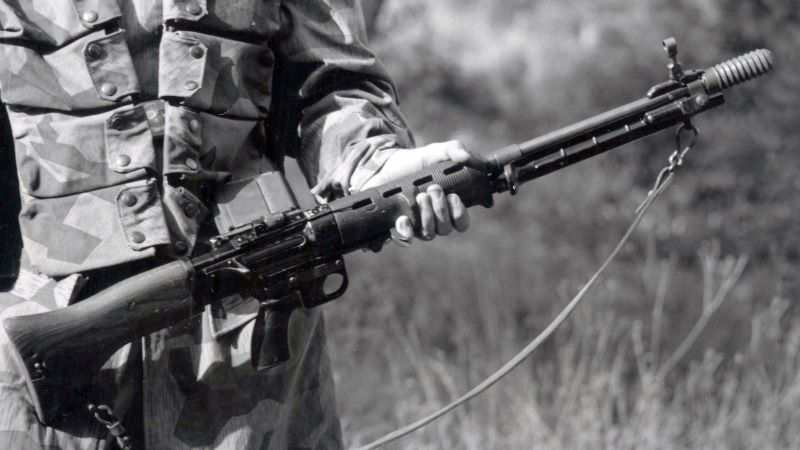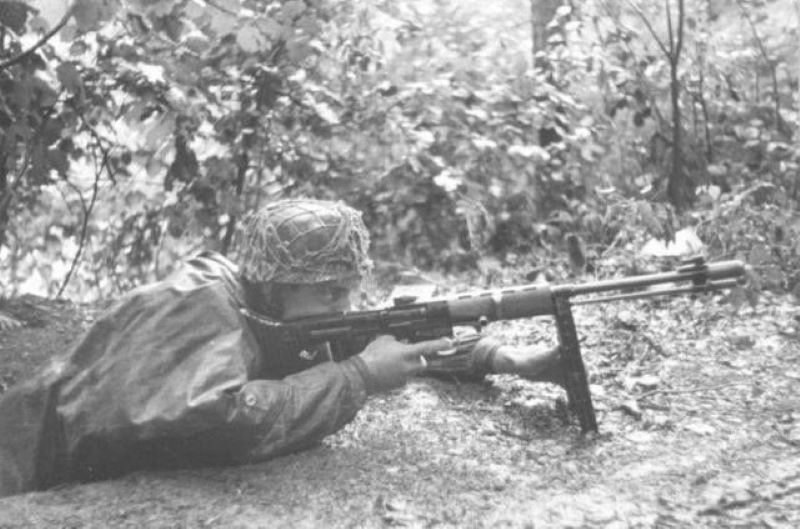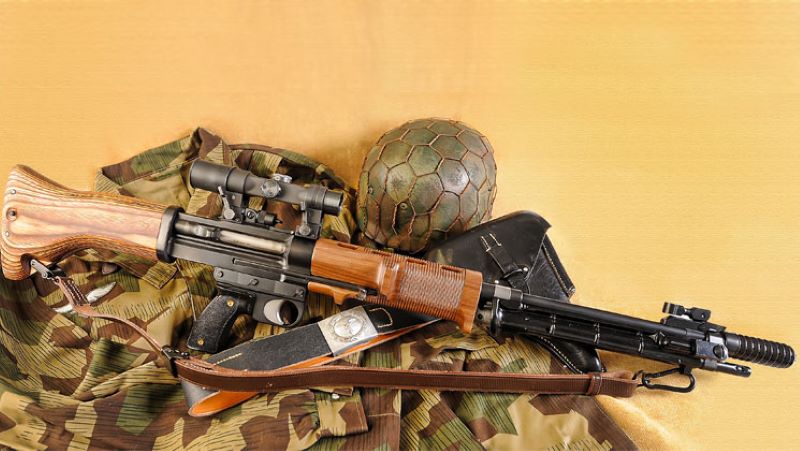The Fallschirmjagergewehr 42, or Paratrooper Rifle 42, was developed for Germany’s airborne infantry in 1942. We’ll take a closer look at this weapon here. What prompted its development? And was it effective? Follow along here and we’ll let you know.
The Inception
Back in 1941, the Luftwaffe (German Air Force) saw the need for a select-fire, hand-held weapon. At the time, paratroopers belonged to the Luftwaffe. The intention was to develop a shoulder-fired weapon that could replace the bolt-action rifle, submachine gun, and light machine gun for paratroopers.
Having one weapon to issue to paratroopers would drastically simplify logistics, which is always a major factor for airborne operations, considering that paratroops could go for extended periods without resupply. Having ammunition and weapon commonality would be a huge boost to the supply chain for airborne operations, with most troops using the same weapons system.
Infighting among departments hinted that the development of such a weapon was unrealistic, and the Army wanted to foist the G41 semi-automatic rifle into the hands of the paratroopers. The Luftwaffe, however, was not appeased by this proposition, and they wanted to move ahead with the development of their special weapon.
Setbacks
Before the program could get off the ground, however, Hitler stepped in and squashed it. He was unimpressed with airborne troops because of their high casualty rates during operations. Herman Goering, the Luftwaffe Reichsmarschall, ordered the project to move ahead behind Hitler’s back despite the Fuhrer’s misgivings.
Hitler’s misgivings stemmed from the high casualties of their first major airborne assault, which happened on Crete. At the time, the doctrine of the German paratroops dictated that most of their weapons were stored in packs, which were dropped along with the paratroopers, who carried mainly 9mm pistols and submachine guns on their person for the jump. Once on the ground, they would retrieve their weapons and begin fighting in earnest. However, the practice of landing practically unarmed while under fire did not prove to be an effective one in combat, resulting in many unnecessary casualties.
Specifications
Initial specifications indicated that the weapon should not be longer than 39.4 inches in length and should not be much heavier than the Karabiner 98 bolt-action rifle. It should be able to fire single shots from a closed bolt but also permit fully automatic fire from an open bolt. Feeding would be from 10 and 20-round magazines and it must be able to mount a bayonet and fire rifle grenades.
Although the 7.92x33mm Kurz round had been developed for the up-and-coming StG 44 assault rifle was available, the Luftwaffe adamantly insisted that the FG-42 be chambered for the full power 7.92x57mm Mauser rifle round.
The weapon was air-cooled and utilized a straight-line stock similar to the MG-34 and MG-42, which greatly helped to reduce recoil in full auto fire.

The rear diopter sight was of the flip-up variety and adjustable for 100 to 1,200 meters in 100-meter increments. The receiver had a long, dove-tailed base designed to accept scope mounts. The scope mounts had locking levers so scopes could be quickly mounted or removed, depending on the mission at hand.
The magazines were inserted on the left side, where the magazine protruded from the rifle. Cartridge ejection occurred on the right side of the receiver. Because the magazine housing was mounted on the side of the receiver, the bolt could extend into the stock, which allowed the overall length of the rifle to be shorter.
All things considered, it’s not quite a machine gun. It’s a little more than a battle rifle, sort of like an automatic rifle. It’s difficult to place this weapon into one single category since it overlaps a few of them.
Modes Of Operation
The FG-42 has a somewhat unique (at least, for the time) dual mode of operation, in that it would fire single shots from a closed bolt. In this configuration, it was more accurate than on full auto.

During full-auto fire, the rifle fired from the open bolt. The advantage of the open bolt is that it allows the action to cool between shots, preventing “cook-offs” when the chamber heats up so much that the ammunition inside can inadvertently fire because of the heat in the chamber.
Prototypes
Development continued and led the Germans through six different prototypes from a litany of manufacturers, including Mauser. Mauser’s prototype was rejected because it was too heavy and it was belt-fed.
Another prototype was developed using sheet metal throughout the construction and a handguard that used resin-impregnated fiber, which protected better against heat and offered a better grip when wet. Although this model showed various shortcomings, development continued. It would be tested again, and then further developed. After several rounds of testing and modifications, the final model was eventually accepted as the FG-42.
A pre-series batch of 50 weapons was given the go-ahead to be produced. Samples from this lot experienced issues, and the design had to be further refined.
Production
The Rheinmetall design originally used heavy amounts of chrome-nickel steel, which was a strategic alloy that was in short supply. The material specifications were changed to manganese steel when the Luftwaffe was permitted to produce 3,000 weapons for combat trials. In fact, throughout the weapon’s production, it was constantly refined and adjusted, leading to several variants. These variants received no separate designations, with all being referred to as the FG-42.
Issued Weapons
At the point where approximately 2,000 weapons had been built and issued, the manganese steel that was being used to construct the receivers was diverted to other projects. As a result of this, sheet steel had to be used in its place.

However, this lighter-weight version was not able to stand up to the recoil of the full-power rifle rounds. Various changes had to be made to the FG-42, including relocating the bipod to the front of the muzzle, and changing the angle of the pistol grip so that it was closer to being vertical. Weight was added to the bolt and its length of travel was lengthened to lower the cyclic rate. The stock was changed to wood from the prior stamped steel. A gas regulator was also fitted, and this allowed the rifle to be fired with various types of ammunition.
Throughout its tenure, the FG-42 was constantly in short supply; Germany could not come close to equipping all of their paratroopers with one. It was largely used by the 2nd Parachute Division in Carentan and the Falaise Pocket after the D-Day invasion.
Additionally, the FG-42 served in Italy, Bosnia, France, and in the defense of Berlin.
Actual Use
Reportedly, the paratroopers who used the FG-42 were relatively satisfied with it. One criticism was that the magazine, which extended from the left side of the receiver, made the weapon heavier on that side.

Sadly, I don’t have access to an FG-42 to play with (such are the injustices of life). However, I have watched videos of these weapons being fired. The FG-42 appears to be fairly stable when fired in full-auto mode, without much muzzle rise, at least during short bursts. With longer bursts, it would recoil off target. The rate of fire is approximately 750 rounds per minute.
The charging handle reciprocates and the brass is ejected vigorously, so this is a right-handed-only weapon. Just forward of the hand guard, there is a gas vent, and if the hand is there, it will be burned by escaping gas.
The magazine, when inserted, is rocked similarly to an AK-47 magazine, from front to rear. There is a bolt hold open device for after the last round is fired.
In Summary
These days, finding an authentic, original FG-42 is tougher to find than hens’ teeth. Only a few thousand were made during WWII, and there simply aren’t many originals. Originals fetch astronomical prices.
Did the FG-42 fulfill the mission for which it was intended? As far as the paratroopers are concerned, it seems to have done a good job. The rifle provided accurate semi-auto fire and delivered full auto fire similar to an automatic rifle or light machine gun. It was also reasonably durable.
It makes me wonder if it might have been more successful had the Germans chambered it in their 7.92×33 Kurz round that the StG-44 was chambered in. There would have been less recoil, leading to more controllability in full automatic fire. Fewer design modifications would have been necessary because the shorter round would have not been as powerful or punishing on the weapon. But we’ll never know because that never happened.
As it stands, the FG-42 has a very unique niche in military history.


